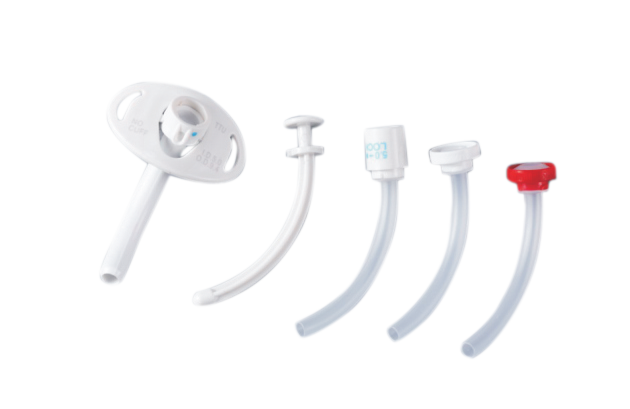
The TTU tracheostomy tube is a medical device that is inserted into the trachea (windpipe) to provide an airway for patients who cannot breathe on their own. It is commonly used in patients who have had a tracheostomy, which is a surgical procedure to create an opening in the neck in order to insert the tube. The TTU tracheostomy tube is made of soft, flexible material and has a large inner diameter that allows for easy breathing. It also has a cuff that can be inflated or deflated in order to seal off the airway when needed.
| Ref. No.: | Size: | Qty. Cs: |
|---|---|---|
| NMR100831 | 5.0 | 100 |
| NMR100836 | 6.5 | 100 |
| NMR100841 | 7.0 | 100 |
The TTU tracheostomy tube is a medical device that is inserted into the trachea (windpipe) to provide an airway for patients who cannot breathe on their own. It is commonly used in patients who have had a tracheostomy, which is a surgical procedure to create an opening in the neck in order to insert the tube. The TTU tracheostomy tube is made of soft, flexible material and has a large inner diameter that allows for easy breathing. It also has a cuff that can be inflated or deflated in order to seal off the airway when needed.
A TTU tracheostomy tube is a type of medical device that is inserted into the trachea (windpipe) to allow breathing. The tube has a small opening at the end that goes into the trachea and a larger opening at the other end that goes outside of the body. The larger opening is covered with a cap or plug. The TTU tracheostomy tube is also known as an uncuffed tracheostomy tube.
A TTU tracheostomy tube is a type of medical device that is inserted into the trachea (windpipe) through an incision in the neck. The tube is used to maintain an airway and to allow for suctioning of secretions. It can also be used to deliver oxygen or other gases.
A tracheostomy is a medical procedure that involves making a small incision in the neck in order to insert a tube into the windpipe. This tube is then used to help the person breathe. A TTU tracheostomy tube is an uncuffed tube that is commonly used for people who have had a tracheostomy. This type of tube is less likely to cause irritation or damage to the trachea and surrounding tissues.
There are many different types of tracheostomy tubes available on the market, each with its own set of pros and cons. One type of tube that is gaining popularity is the TTU, or Tracheostomy Tube Uncuffed. This type of tube has a number of advantages over other types of tracheostomy tubes, but it also has some disadvantages that should be considered before deciding if it is the right type of tube for you or your loved one.
The biggest advantage of TTU tracheostomy tubes is that they are much less likely to cause damage to the trachea than other types of tubes. This is because the tube is not inserted all the way into the trachea, but rather just far enough to allow air to flow through. This means that there is less chance of the tube causing irritation or inflammation to the sensitive tissues lining the trachea.
Another advantage of TTU tracheostomy tubes is that they are easier to care for than other types of tubes. This is because they do not need to be replaced as often, and because they are less likely to become blocked or damaged.
A TTU tracheostomy tube is a type of tracheostomy tube that is used to provide an airway for patients who cannot breathe on their own. The TTU tracheostomy tube is inserted through a small incision in the neck and into the trachea (windpipe). The TTU tracheostomy tube has a cuff that helps to keep the airway open and prevents air from leak around the tube. There are several different types of TTU tracheostomy tubes available, and your doctor will choose the type that is best for you.
The care of a TTU tracheostomy tube is similar to the care of any other type of tracheostomy tube. It is important to keep the area around the tube clean and free from infection. TheTTU tracheostomy tube should be checked regularly to make sure that it is secure and that there are no leaks. The cuff should be inflated as needed to maintain an airtight seal. If you have any questions about the care of your TTU tracheostomy tube, please contact your doctor or healthcare team.